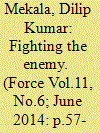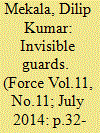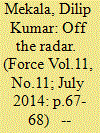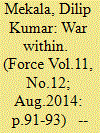|
|
|
Sort Order |
|
|
|
Items / Page
|
|
|
|
|
|
|
| Srl | Item |
| 1 |
ID:
131042


|
|
|
|
|
| Publication |
2014.
|
| Summary/Abstract |
If the Ministry of Home Affairs (MHA) were to be believed, the paramilitary forces fighting the internal security battle - especially in the Red Corridor - were provided with the best equipment. The paramilitary personnel, however, think otherwise. Either it is inadequate number of weapons and systems, or inefficient training; till now the paramilitary forces have not been able to handle the security situation in the Naxal stronghold areas. Latest in the long list of disappointments were the incidents of Naxal attacks during the General Elections.
On April 12, Bastar and Bijapur districts in Chhattisgarh witnessed Improvised Explosive Devices (IED) blasts during the voting season. Maoists triggered landmines in these two areas which claimed the lives of seven polling officials and five Central Reserve Police Force (CRPF) personnel. Three days later, another blast was carried out which killed three security forces. On May 11, seven cops were killed in yet another landmine blast in Gadchiroli district in Maharashtra.
When asked for MHA's assessment on these security lapses, a highly placed official in the ministry said that the paramilitary personnel were in the 'election mode', and as a result security vacuum was created. He implied that it was not physically possible to ensure full safety in this so-called 'election mode'. He then tossed over the responsibility and blame on to the director generals (DG) of the paramilitary forces. "The top leadership of the paramilitary forces could have done better by ensuring proper training to their troops," he said. Giving the example of mini-training centres, which were the brain-child of the then DG CRPF Vijay Kumar, the MHA official said that the DGs did not take this idea forward. Apparently, lack of coordinated efforts between the top officials led to the lack of training.
|
|
|
|
|
|
|
|
|
|
|
|
|
|
|
|
| 2 |
ID:
132262


|
|
|
|
|
| Publication |
2014.
|
| Summary/Abstract |
A wide variety of state-of-the-art UGS systems are now available in the market
The use of unattended ground sensors (UGS) for border security applications has gained momentum in recent times across the world. For India, where the border guarding forces face significantly large number of challenges manning the open and porous borders, the UGS could provide a perfect solution. It is no surprise that Indian armed forces are now in the process of procuring these advanced sensors.
The ministry of home affairs (MHA) had issued an expression of interest (EoI) in 2013 to procure UGS systems for Border Security Force (BSF). This initiative from the MHA came after the reports of a 400 metre long tunnel was found in Jammu and Kashmir close to the international border. "Hand-held control receiver and variety of sensors like, passive infrared sensor to detect movement of object in a narrow field of view, magnetic sensors to monitor movement of metallic objects such as weapons or vehicles and seismic sensors to identify ground vibration caused by vehicles or pedestrians (should be encompassed in the device)," stated the qualitative requirements floated by the Paramilitary.
|
|
|
|
|
|
|
|
|
|
|
|
|
|
|
|
| 3 |
ID:
132267


|
|
|
|
|
| Publication |
2014.
|
| Summary/Abstract |
The government should speed up its project of integrating India's coastline into one radar network The horrific terror attack on Mumbai on 26 November 2008 exposed the vulnerability of the Indian continent via the sea route. Immediately after, the ministry of home affairs (MHA) planned to integrate the entire coastline into one radar network which can seamlessly monitor movements in the sea. The government entrusted Bharat Electronics Limited (BEL) with the responsibility of establishing a chain of 46 static radar sensors along the coastline in Phase-I of the project. Out of these, 36 were planned to be implemented on the mainland while the remaining 10 were to be set up on the islands. As of August 2013, BEL's project was able to activate only 34 radar stations on the mainland.
|
|
|
|
|
|
|
|
|
|
|
|
|
|
|
|
| 4 |
ID:
132820


|
|
|
|
|
| Publication |
2014.
|
| Summary/Abstract |
If asked, ministry of home affairs (MHA) downplays this, but India's internal security battle is being fought by the most disgruntled, demotivated paramilitary troops. The reason for such a shameful situation is the inaction by the ministry in resolving the grievances of the forces. FORCE has interacted with many officers below Commandant rank deployed in operational positions, who claim that the weak leadership is to be blamed entirely for the situation.
MHA has often painted a rosy picture that all is well within the forces. Even in the Parliament recently, while explaining the reason behind huge number of Central Reserve Police Force (CRPF) officers quitting their jobs, the ministry stated that it is "normal and acceptable". From 2009 to 2012, in the CRPF alone 16,523 officers quit their jobs. What is more baffling is the casual tone of reasoning that the ministry has provided in justifying this issue. "The causative factors in most of the cases were mainly found to be various personal and domestic reasons… Some personnel seek voluntary retirement to enjoy a static life as well as pensionary benefits after completion of 20 years of regular service," said minister of state (home), Kiran Rijiju.
What MHA conveniently did not state in the reply to the Parliament is that most of the officers who quit their jobs were troubled by their uncertain career progression - they believed that no due credit was given for risking their lives in conflict zones. Poor salary also caused a lot of dissatisfaction. Presently, there are at least 10,000 officers from all paramilitary forces fighting various legal cases in the courts, thus proving that all's not well within.
|
|
|
|
|
|
|
|
|
|
|
|
|
|
|
|
|
|
|
|
|